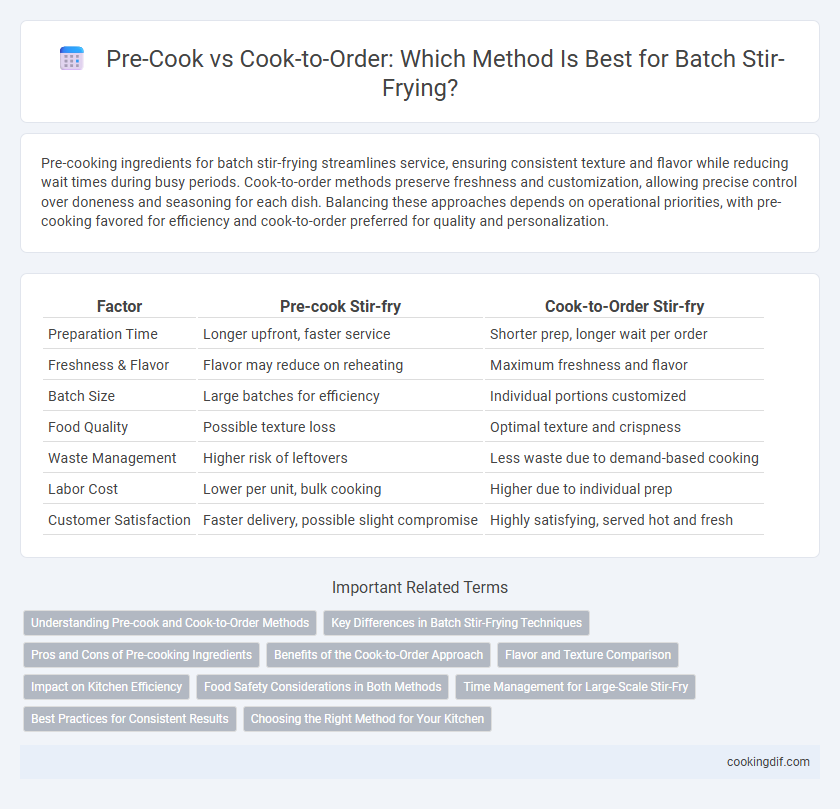Pre-cooking ingredients for batch stir-frying streamlines service, ensuring consistent texture and flavor while reducing wait times during busy periods. Cook-to-order methods preserve freshness and customization, allowing precise control over doneness and seasoning for each dish. Balancing these approaches depends on operational priorities, with pre-cooking favored for efficiency and cook-to-order preferred for quality and personalization.
Table of Comparison
| Factor | Pre-cook Stir-fry | Cook-to-Order Stir-fry |
|---|---|---|
| Preparation Time | Longer upfront, faster service | Shorter prep, longer wait per order |
| Freshness & Flavor | Flavor may reduce on reheating | Maximum freshness and flavor |
| Batch Size | Large batches for efficiency | Individual portions customized |
| Food Quality | Possible texture loss | Optimal texture and crispness |
| Waste Management | Higher risk of leftovers | Less waste due to demand-based cooking |
| Labor Cost | Lower per unit, bulk cooking | Higher due to individual prep |
| Customer Satisfaction | Faster delivery, possible slight compromise | Highly satisfying, served hot and fresh |
Understanding Pre-cook and Cook-to-Order Methods
Pre-cook methods in batch stir-frying involve partially cooking ingredients in advance, reducing total cooking time and ensuring consistency during high-demand periods. Cook-to-order techniques prioritize freshness by completing the entire stir-fry process after receiving the order, enhancing flavor and texture but requiring longer wait times. Balancing these approaches depends on operational needs, ingredient types, and customer expectations for quality and speed.
Key Differences in Batch Stir-Frying Techniques
Batch stir-frying techniques differ primarily in timing and freshness, with pre-cook methods emphasizing efficiency by partially cooking ingredients in advance, allowing quick final stir-frying during service. Cook-to-order prioritizes food quality and texture by stir-frying ingredients entirely at the moment of ordering, ensuring optimal flavor and temperature. Pre-cook suits high-volume operations seeking speed, while cook-to-order aligns with gourmet or customized dining experiences focused on freshness.
Pros and Cons of Pre-cooking Ingredients
Pre-cooking ingredients in batch stir-frying enhances workflow efficiency and reduces total cooking time, ensuring consistent texture and flavor control. However, it can lead to diminished freshness and potential nutrient loss compared to cook-to-order methods, impacting the final dish's quality. Proper storage and reheating techniques are essential to maintain food safety and optimal taste when pre-cooking.
Benefits of the Cook-to-Order Approach
Cook-to-order batch stir-frying preserves the freshness and vibrant texture of vegetables and proteins, enhancing overall flavor profiles compared to pre-cooking. This approach minimizes nutrient loss and prevents overcooking, ensuring optimal taste and nutritional value in each serving. Personalized customization and reduced food waste further contribute to operational efficiency and improved customer satisfaction.
Flavor and Texture Comparison
Pre-cooking stir-fry ingredients in batches preserves consistent texture but can lead to diminished flavors due to moisture loss and cooling before serving. Cook-to-order stir-frying locks in freshness and enhances vibrant flavors with crisp textures, as ingredients are quickly seared at high heat. Balancing speed and quality, many kitchens opt for partial pre-cooking combined with final quick searing to maintain optimal flavor and texture.
Impact on Kitchen Efficiency
Pre-cooking ingredients in batch stir-frying significantly reduces cooking time during order fulfillment, enhancing kitchen throughput and minimizing wait times. Cook-to-order methods ensure maximum freshness and customization but can slow down service during peak hours, potentially causing bottlenecks. Balancing pre-cook and cook-to-order approaches optimizes workflow, improves order accuracy, and maintains consistent dish quality in high-volume kitchens.
Food Safety Considerations in Both Methods
Pre-cooking ingredients for batch stir-frying requires rapid cooling and proper refrigeration to prevent bacterial growth, while cook-to-order maintains food freshness by minimizing holding time but demands efficient kitchen workflow to ensure timely preparation. Both methods necessitate strict temperature control, with pre-cooked items needing reheating to at least 165degF (74degC) before serving and cook-to-order dishes requiring thorough cooking of raw ingredients on-demand. Proper hygiene practices and continuous monitoring of cross-contamination risks are critical to maintaining food safety in high-volume stir-fry operations.
Time Management for Large-Scale Stir-Fry
Pre-cooking ingredients for batch stir-frying significantly reduces active cooking time during service, enabling efficient handling of large orders by minimizing stove crowding and ensuring consistent heat distribution. Cook-to-order methods, while preserving optimal freshness and texture, increase overall preparation time and require precise timing to avoid delays. Balancing pre-cook preparation with rapid final stir-frying maximizes throughput and maintains quality in high-volume commercial kitchens.
Best Practices for Consistent Results
Pre-cooking ingredients for batch stir-frying ensures uniform texture and color, reducing variability during final cooking. Cook-to-order methods preserve ingredient freshness and optimal heat application but require precise timing and skilled coordination. Balancing these techniques with proper ingredient staging and temperature control achieves consistent, high-quality stir-fry outcomes in commercial kitchens.
Choosing the Right Method for Your Kitchen
Pre-cook batch stir-frying ensures consistent quality and faster service during peak hours by preparing ingredients in advance, ideal for high-volume kitchens. Cook-to-order offers freshness and customization, best suited for establishments prioritizing personalized customer experiences and smaller order sizes. Evaluating kitchen resources, staff capacity, and customer expectations helps determine the most efficient stir-fry cooking method.
Pre-cook vs cook-to-order for batch stir-frying Infographic

 cookingdif.com
cookingdif.com